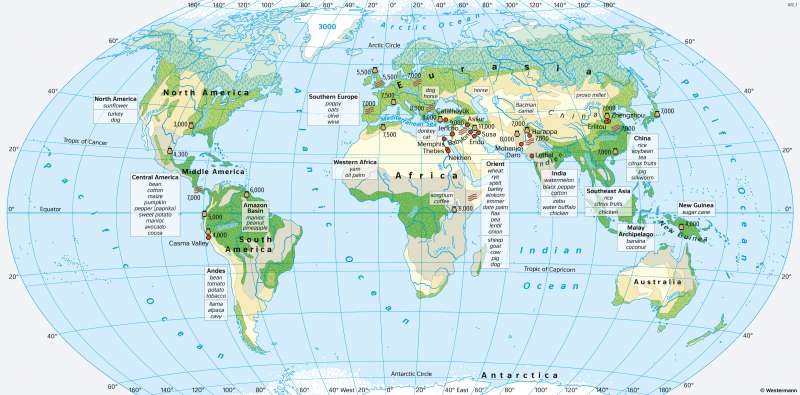The World - Neolithic revolution and the beginning of civilisation
Prehistory
978-3-14-100890-6 | Page 26 | Ill. 2

Overview
For almost 2.5 million years, humans were hunter-gatherers. Even Homo sapiens did not change this for a long time. It was not until around 11,500 years ago, after the end of the last ice age, when the climate became significantly warmer and there was also more precipitation, that some people in the region of the Fertile Crescent in the Near East took the step from hunting and gathering to agriculture and settlement. This development, perhaps the most fundamental in human history, was momentous not only for food supply, but also for society, individuals, and the entire development of human culture.
The Neolithic Revolution
This step is called the Neolithic "Revolution", but it was by no means abrupt and sudden. The transitions were much more fluid. The essential features of the "Neolithic package" - settlement, domestication of wild animals and plants, pottery production for storage - appeared in different sequences and was different on all continents. The more or less favourable natural conditions played a decisive role. Since the Neolithic period, only 14 large domestic animal species (weighing more than 45 kg) have been domesticated worldwide, and most of these have only regional distribution (e.g. dromedary, reindeer, yak). Only five species are of global importance, namely goat, sheep, pig, cattle and horse (the "big five"). They were all present in Eurasia - along with nutritious wild grasses and legumes - while other regions of the world almost completely lacked them. It is no coincidence that all major early civilisations developed at a similar latitude between the Fertile Crescent and eastern China.
The first farmers in the Near East domesticated emmer, barley, einkorn, wheat and flax, but also legumes such as broad beans, beans, lentils and chickpeas. In their mud-brick houses, they constructed special areas to protect the supplies from vermin as early as 9500 BC. The first domestic animals, apart from the dog, which had already accompanied the hunter-gatherers, were goats and sheep, which provided meat and milk, hides and wool. Domestic pigs could be found from the late 8th millennium BC in Asia Minor, the Near and Middle East, then also in Southeast Asia and China. Cattle were domesticated from about 6000 BC in the Near East, Pakistan, and North Africa. They provided milk, meat, hides, dung (first as heating material, later also as fertiliser), and, with the rise of advanced civilisations, they were also used as beasts of pack and draught animals. A latecomer among the "big five" was the horse, which was tamed and bred around 4000 BC by pastoral nomads of the Asian steppes (including Yakuts and Kirghiz).
Early advanced civilisations
The transition to agriculture also occurred widely scattered elsewhere, for example in the eastern USA, Central America and the Andean region, West Africa, Southeast Asia, New Guinea, the Indo-Pakistan border region and eastern China. In some places, however, there were only a few possible choices for domestication. In sub-Saharan Africa and Australia, they were completely absent. Elsewhere, they were too unproductive to establish an exclusively productive way of life there. In contrast, historically significant advanced civilisations developed in Mesopotamia, the Indus region and along the Yellow River in China, and later in Egypt. Their characteristic common feature was their intensive dependence on a river system.
Settlement as a way of life reached Central and Western Europe through cultural transfer. From Anatolia, peasant culture spread through Greece and south-eastern Europe. To the originally used agricultural plants and domestic animals, poppy and presumably also oat were added as originally European agricultural plants. The Linear Pottery culture, based on agriculture, spread from Eastern Europe to present-day France from the middle of the 6th millennium BC. The Linear Pottery people, named after the shape and ornamentation of their ceramic vessels, always settled on fertile loess soils, built identical houses everywhere, cultivated identical types of grain and founded a uniform European culture, which was only broken up at the beginning of the Middle Neolithic (around 5000 BC) and disintegrated into regional cultural groups.
The advanced civilisations not only brought innovations in agriculture (plough, draught animals, irrigation), but also established decisive cultural and social innovations. Jericho (founded in the 10th millennium BC, fortified from around 8000 BC) is considered one of the oldest cities in the world. The founding of settlements led to a differentiation and perfection of crafts based on the division of labour, and the population increasingly split into different occupational groups (farmers, craftsmen, warriors, priests, later officials and traders) as the urban centres grew. The invention of the wheel, the potter's wheel, the beginnings of copper processing and first writings were among the numerous technical-cultural achievements that were only possible in advanced civilisations.




